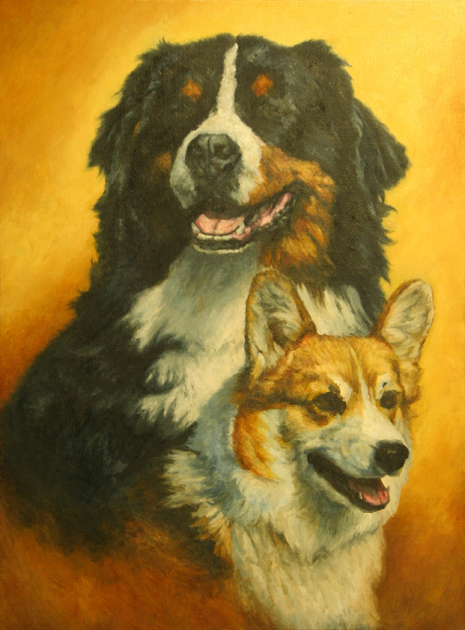Oil Painting Progression, Part 5 – “Nothin’ but Fluff”
Now we find ourselves coming into the final stages of the Larka and Dylan oil painting. For those who’ve been following along, we’ve been through a lot! Going from rough “scribbles” as it were, through some satisfying early stages of dogs actually looking like dogs, then back to roughing everything up all over again! If this sounds like madness, feel free to go back and check out the articles leading up to here, and see whether the “method” to it makes any sense. In any event, we left off with some pretty thick paint layering – a nice solid base of oil paint worthy of receiving the final layers which will round out a traditional-style piece of animal art. So today, it’s “nothin’ but fluff” – taking that solid, but decidedly rough, layering of paint and turning it into our furry friends we’ve been after this whole time!

The thick blocky areas of light and dark, along with their corresponding colors, which have been laid in previously both show through and inform the direction and color of the finer paint strokes which have been added in the image above. Again, the goal here is to get back to the dogs’ realistic furry texture, but this time without the thinness and transparency which characterized the earlier stages of the painting. It’s important to note that this process isn’t simply a matter of methodically painting in individual hairs, or even clumps of hairs. Yes, we are trying to selectively achieve these textural elements, but they also serve a “greater” cause. That cause is to continue to create the illusion of light playing on form or three-dimensionality. So as the brushstrokes representing the dogs’ hair are laid in, their color, direction, and character are chosen to achieve this end. Doing so is more important now than at any previous stage because this layer of paint, in large measure, is what will be seen on the surface of the final picture. I’m interested in creating the soft feeling of fur and a sense of detail, without sacrificing that painterliness which can make works in oil so engaging.
If you’re a traditional oil painter, chances are you’re familiar with the concept of “fat over lean.” While I’ve been discussing thick paint versus thin, I’ve been mindful of the important mechanical process of applying the paint layers in order of increasing thickness as the surface is built up. The thin, washy layers should be on the bottom and the thicker brushstrokes on top. Now obviously there’s an interlacing of brushstrokes throughout, and layers aren’t applied like layers of pavement on a road. But, due to the extended drying time of oil paint, and different rates of drying depending on paint thickness, keeping the thicker layers on top avoids cracking of the thinner layers, which may occur if those thin layers were applied over the thick. Hence the adage “fat over lean.”
It may be noted that while a large percentage of this painting’s surface is dedicated to dog hair, there are other tissues and textures I’ve been paying attention to throughout the stages of the artwork. These include the animals’ noses, tongues, teeth and, at certain stages especially, the eyes. We’ll see more of that in the next article in this series. In addition, the subtle glow of the background has been receiving treatment, as it should harmonize with the subject matter in every way, enhancing and even melding with it, but without distracting from it, allowing the dogs to stand out as if in an actual three-dimensional space.
